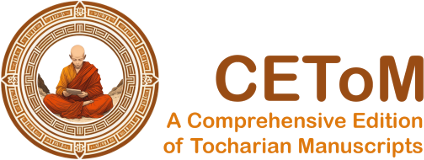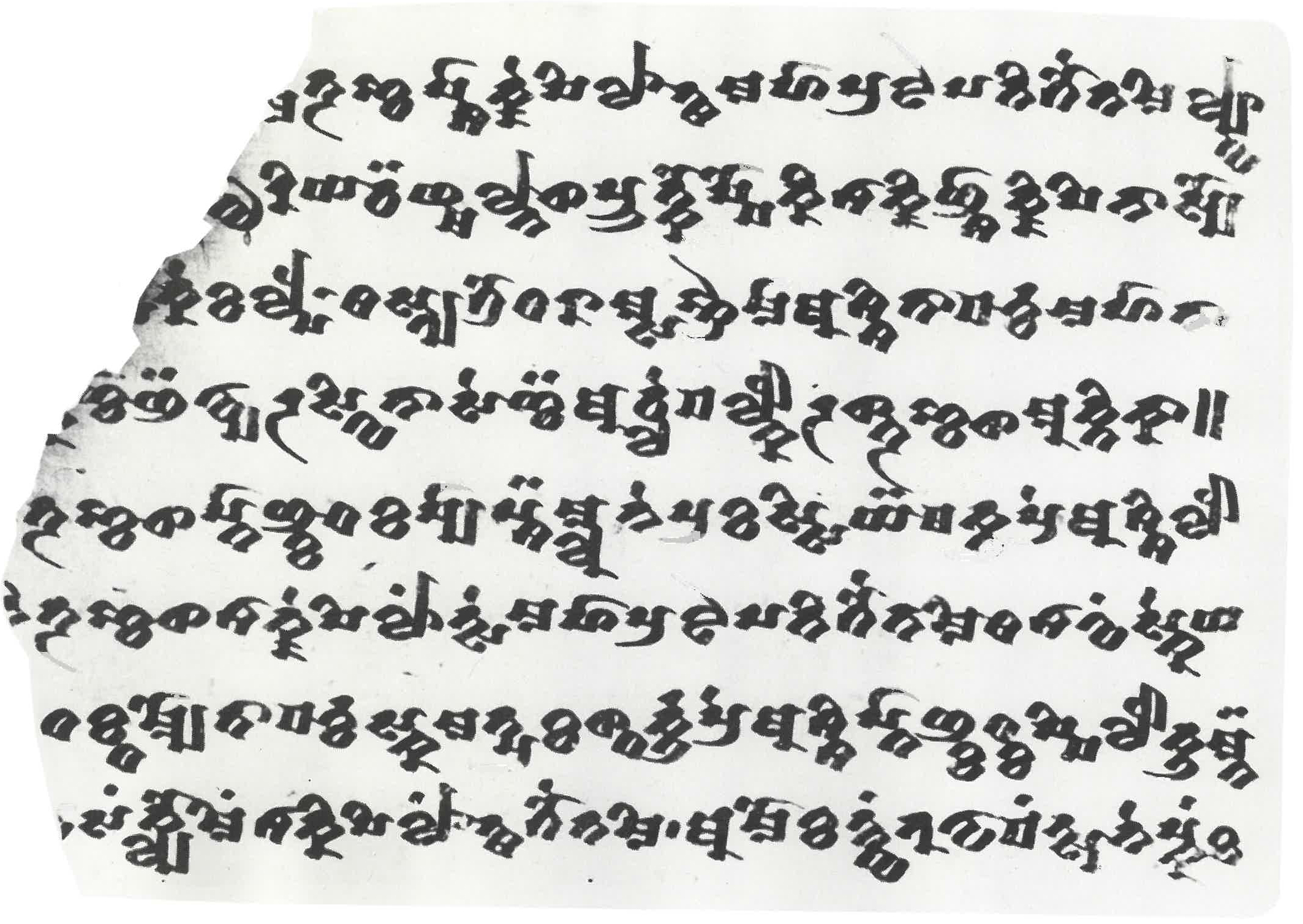Work in progress
YQ III.1
| Known as: | YQ III.1; YQ 1.21 |
|---|
| Cite this page as: | "YQ III.1". In A Comprehensive Edition of Tocharian Manuscripts (CEToM). Created and maintained by Melanie Malzahn, Martin Braun, Hannes A. Fellner, and Bernhard Koller. https://cetom.univie.ac.at/?m-yqiii1 (accessed 12 Jul. 2025). |
|---|
Provenience |
| Main find spot: | Qigexing |
|---|
| Collection: | Xinjiang Museum (Ürümchi) |
|---|
Language and Script |
| Language: | TA |
|---|
| Script: | classical |
|---|
Text contents |
| Title of the work: | Maitreyasamiti-Nāṭaka |
|---|
| Passage: | Act 3.1 |
|---|
| Text genre: | Literary |
|---|
| Text subgenre: | Drama |
|---|
| Verse/Prose: | prose; verse |
|---|
| Meter: | 543 (4x); 4343 (4x) |
|---|
Object |
| Manuscript: | Yanqi |
|---|
| Material: |
ink
on paper |
|---|
| Form: | Poṭhī |
|---|
| Number of lines: | 8 |
|---|
Images
Transliteration
| a1 | /// ma tra ṅka ṣśā kke ṣi lā¯ ¯ts ma hā pra jā pa ti gau ta mi lywā |
|---|
| a2 | /// ·tu ri ya¯ ¯cä śma lna¯ ¯s̝ pru tko ṣṣo ki śā kki ñśā kki ṣi nā syo |
|---|
| a3 | /// ·[s]· ke ka lpe • sa snya gro dha rā msa ṅkrā mā a śśi tā pa¯ ¯rk ma hā nā |
|---|
| a4 | /// ·[k]· ñc[ā]¯ ¯ñä wyā ra swi nā se¯ ¯ñcä a cle pa lko ra s̝tra ṅka¯ ¯s̝ mu kti kā || |
|---|
| a5 | /// tra ṅka¯ ¯s̝ ptā ñka¯ ¯t ka ṣyā pśä mlu ne pra ka ssi yä¯ ¯m ku pre a śśi lo |
|---|
| a6 | /// [ni] tra ṅka¯ ¯s̝ śā kke ṣi lāṃ tse ma hā pra jā pa ti gau ta mi¯ ¯s śā waṃ ske ya |
|---|
| a7 | /// ta kta myo tā pa¯ ¯rk ska ma tpra ka s̝ta rku pre a śśi ptā ñka tka ṣṣi lo ku mnä |
|---|
| a8 | /// [wā] saṃ klyo miṃ śā ki ṣi lāṃ¯ ¯ts gau ta mi : a mo ka ntwaṃ nu wā paṃ tsu ne pukaṃ ka |
|---|
| b1 | /// [ma] ntpa tnu ta mpa pyu tkā¯ ¯t : 1 || pa ṭṭī ni tra ṅka¯ ¯s̝ ku pre ne wā pa lyi |
|---|
| b2 | /// ā la kyā ma¯ ¯s || pa ṭṭi nī tra ṅka¯ ¯s̝ || a ptsa ra da rśnaṃ || ma ccā¯ ¯k ṣñi |
|---|
| b3 | /// pyā ṣtṣā ma lke yo pa kku¯ ¯nt ma ccā ksā ma ta¯ ¯m : ma ccā kpe wa tma ccā ka¯ ¯k |
|---|
| b4 | /// ka¯ ¯k wā pa tka na kwā kma tsaṃ : 1 || wā skā¯ ¯ñcä tra ṅka¯ ¯s̝ yne śñu¯ ¯k ptā ñka |
|---|
| b5 | /// (·)[m]ā vi pa śyi ptā ñkte sunu¯ ¯m pyā pyo śwā tsi yo ktsi yo ka lyme yā spā |
|---|
| b6 | /// ñka tka ṣyā¯ ¯p tsku nteṃ mā ca rtā¯ ¯k • ska ma¯ ¯t śä ks̝a kpi puka lye śo mi |
|---|
| b7 | /// [ṣu] rmtā pa¯ ¯rk śā kke ṣi lā¯ ¯ts ma ccā kka¯ ¯r ka ppā ssā ryā • ma ccā |
|---|
| b8 | /// [k]ṣā śā kki śśi pa lka ṣmā e rkā tu ne pa lkā¯ ¯r klyo miṃ ttā |
|---|
Transcription
Translation
| a1 | ... that (girl) says: |
|---|
| a1+ | The queen of the Śākyas Mahāprajāpatī Gautamī has sent (me) (to ask when the Buddha-god the teacher) will come (from the city of Śrāvastī) to the city of Kapilavastu. |
|---|
| a2+ | The Śākya men are, as it were, crowded by Śākya women, ... |
|---|
| a3+ | ... I have got the opportunity (to ask) whether at the Nyagrodhārāma monastery, he, Mahānāman (by name), (might) now ... |
|---|
| a4 | ... the lay-women worship the Vihāras. Having seen ..., Muktikā says: |
|---|
| a4+ | || (Paṭṭinī) says: |
|---|
| a5+ | I come here to ask about the coming of the Buddha-god the teacher, when he (is about to come). |
|---|
| a6 | (Paṭṭi)nī says: |
|---|
| a6+ | With great efforts on the part of the Śākya queen Mahāprajāpatī Gautamī, (a cloth) has come into existence. |
|---|
| a7+ | Therefore she now keeps asking when the Buddha-god, the teacher is about to arrive. |
|---|
| a8 | The Śākya queen Gautamī, ... noblest among women, |
|---|
| a8+ | among the skills however weaving is the lowiest of all. |
|---|
| b1 | 1 || |
|---|
| b1 | Why then did she care to do that? Paṭṭinī says: |
|---|
| b1+ | If it was only a matter of weaving ..., |
|---|
| b2 | (Muktikā says:) Besides this, (what) did she do? Paṭṭinī says: || In the Aptsaradarśaṃ [tune] || |
|---|
| b2+ | She herself with her own (hands), ... |
|---|
| b3 | she made (them) grow with boiled milk, she herself gathered them; she herself did the carding, |
|---|
| b3+ | and she herself indeed ... |
|---|
| b4 | 1 || |
|---|
| b4 | ... she (herself) indeed wove the excellent cotton sheet. The lay-woman says: |
|---|
| b4+ | Very clearly, (from) the Buddha-god (the teacher), I, ... |
|---|
| b5+ | formerly (she [Gautamī] worshipped) the Buddha Vipaśyin with perfumed flower, with food and drink, properly [and] piously. |
|---|
| b6 | ... she became the foster mother of Buddha-god the teacher. |
|---|
| b6+ | Always ... (was) of a sixteen years old girl. |
|---|
| b7 | What (is) the reason now that the queen of the Śākyas herself planted the cotton, |
|---|
| b7+ | [and] herself ... |
|---|
| b8 | it shines among ... of the Śākyas, it is not despicable. Look, noble one ... |
|---|
Other
| b7 | What is the reason now that the queen of the Śākyas has sown the cotton just by herself? (cf 147) (Peyrot 2013b: 284) |
|---|
Commentary
Parallel texts
Philological commentary
| * | This fragment contains part of the third act of the Maitreyasamitināṭaka; an Uy. parallel is MaitrHami III, 1a4-2a1. See also Pinault 1999: 196-7. |
|---|
| * | The translation and the following commentary are adapted from Ji et al. 1998: 148. |
|---|
| n1 | The agreement between the Tocharian and the Uyghur text in the first lines is not very close. |
|---|
| n3 | In the Uyghur text, the name of the lay-woman (upāsikā-) is not given until MaitrHami 3, 4 a12. |
|---|
| n4 | The girl Paṭṭinī is now speaking. Starting from here, the agreement between the Tocharian and the Uyghur text (MaitrHami 3, 1 a15ff.) is closer. |
|---|
| n6 | kulewāsaṃ is the first word of a stanza of the type 4 x 12 (5/7) syllables. |
|---|
| n7 | pukaṃ : reading corrected after Schmidt 1999b: 281. |
|---|
| n8 | aptsaradarśnaṃ: a stanza of 4 x 14 (7/7) syllables. |
|---|
Remarks
Linguistic commentary
| n2 | acle is a new form of uncertain meaning. |
|---|
| n5 | The form corresponding to TB wapāttsa should be TA. wāpats*, the abstract of which would be wāptsune*. Therefore, wāpäṃtsune must be derived from wāpaṃts*, which may be the term for female weaver. |
|---|
| n9 | Uyghur upasanč (in the corresponding line and elsewhere) shows a partial resanskritization of a TA wāskāñc, corresponding to Skt. upāsikā- ‘lay-woman’. |
|---|
| n10 | The reading ttā appears to be preferable to ntā: the onset tt- remains unexplained. |
|---|
References
Edition
Ji et al. 1998
Translations
Peyrot 2012a: a6 (203); Peyrot 2013b: a7 (233, 282), b7 (284)
Bibliography
Ji et al. 1998
Ji, Xianlin, Werner Winter, and Georges-Jean Pinault. 1998. Fragments of the Tocharian A Maitreyasamiti-Nāṭaka of the Xinjiang Museum, China. Transliterated, translated and annotated by Ji Xianlin in collaboration with Werner Winter, Georges-Jean Pinault. TLSM 113. Berlin/New York: de Gruyter.
Peyrot 2012a
Peyrot, Michaël. 2012a. “The Tocharian A match of the Tocharian B obl.sg. -ai.” Tocharian and Indo-European Studies 13: 181–220.
Peyrot 2013b
Peyrot, Michaël. 2013b. The Tocharian subjunctive. A study in syntax and verbal stem formation. Vol. 8. Brill’s Studies in Indo-European Languages & Linguistics. Leiden/Boston: Brill.
Pinault 1999
Pinault, Georges-Jean. 1999. “Restitution du Maitreyasamiti-Nāṭaka en tokharien A: Bilan provisoire et recherches complémentaires sur l’acte XXVI.” Tocharian and Indo-European Studies 8: 189–240.
Schmidt 1999b
Schmidt, Klaus T. 1999b. “Review of: Fragments of the Tocharian A Maitreyasamiti-Nāṭaka of the Xinjiang Museum, China.” Tocharian and Indo-European Studies 8: 277–85.




